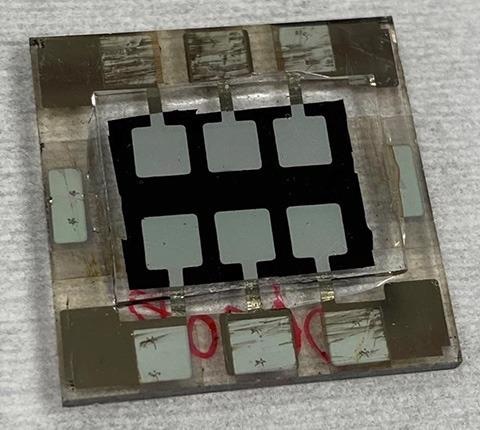Scientists at the National Renewable Energy Laboratory (NREL) of the U.S. Department of Energy have created a tin-lead perovskite cell that solves stability issues and enhances efficiency. The efficiency of the new cell, which is a tandem design with two layers of perovskites, was 25.5%.
 Researchers were able to fabricate this perovskite solar cell that overcomes problems with stability. Image Credit: National Renewable Energy Laboratory (NREL).
Researchers were able to fabricate this perovskite solar cell that overcomes problems with stability. Image Credit: National Renewable Energy Laboratory (NREL).
Perovskites have evolved as an important efficient solar cell material, although research is still on to extend the technology’s lifespan.
Following 1,500 hours of continuous operation or more than 62 days, the new NREL cell maintained 80% of its full efficiency.
This represents an accelerated aging test in the lab. At this tandem efficiency level, the best reported stability in literature is normally several hundred hours.
Kai Zhu, Paper Co-Author and Senior Scientist, National Renewable Energy Laboratory
The paper was published in the journal Nature Energy, which explains the new cell in detail.
The solar cells are formed from a chemical solution glued to a substrate, and perovskite alludes to a crystalline structure rather than a particular element such as silicon.
A tandem perovskite cell, in which two layers are linked to catch slightly distinct slices of the solar spectrum, can be more than 30% efficient, according to the two corresponding authors, Kai Zhu and Jinhui Tong.
Qi Jiang (co-first author), Andrew Ferguson, Axel Palmstrom, Ji Hao, Sean Dunfield, Amy Louks, Steven Harvey, Haipeng Lu, Ryan France, Fei Zhang, Mengjin Yang, John Geisz, Matthew Beard, Darius Kuciauskas, and Joseph Berry are the other co-authors from NREL.
Researchers from the University of Colorado–Boulder and the University of Toledo are among the other contributors.
In an article published in the journal Science in 2019, many of these researchers showed a tin-lead tandem perovskite cell with a 23.1% efficiency. They compensated for any tin-related issues by using the chemical compound guanidinium thiocyanate, which improved the cell’s structural and optoelectronic capabilities significantly.
When sunlight causes electrons to flow, solar cells generate energy. The cell’s efficiency is improved by a longer carrier lifetime associated with mobility. The addition of guanidinium thiocyanate increased the carrier lifetime from less than 200 nanoseconds to 1 microsecond (a nanosecond is a billionth of a second or a millionth of a second).
The scientists improved on the previous experiment by adding phenethylammonium iodide and guanidinium thiocyanate. The carrier lifetime of the enhanced tin-lead perovskite increased to roughly 9 microseconds.
The combined additives also lowered the fault density associated with tin oxidation to levels previously unheard of in tin-lead perovskites and comparable to lead-only perovskites.
The voltage generated by the new cell was also improved, reaching 2.1142 volts. The best-approved tandem equipment, on the other hand, measured 2.048 volts.
The research was sponsored by the Solar Energy Technologies Office of the U.S. Department of Energy.
Journal Reference:
Tong, J., et al. (2022) Carrier control in Sn–Pb perovskites via 2D cation engineering for all-perovskite tandem solar cells with improved efficiency and stability. Nature Energy. doi:10.1038/s41560-022-01046-1.